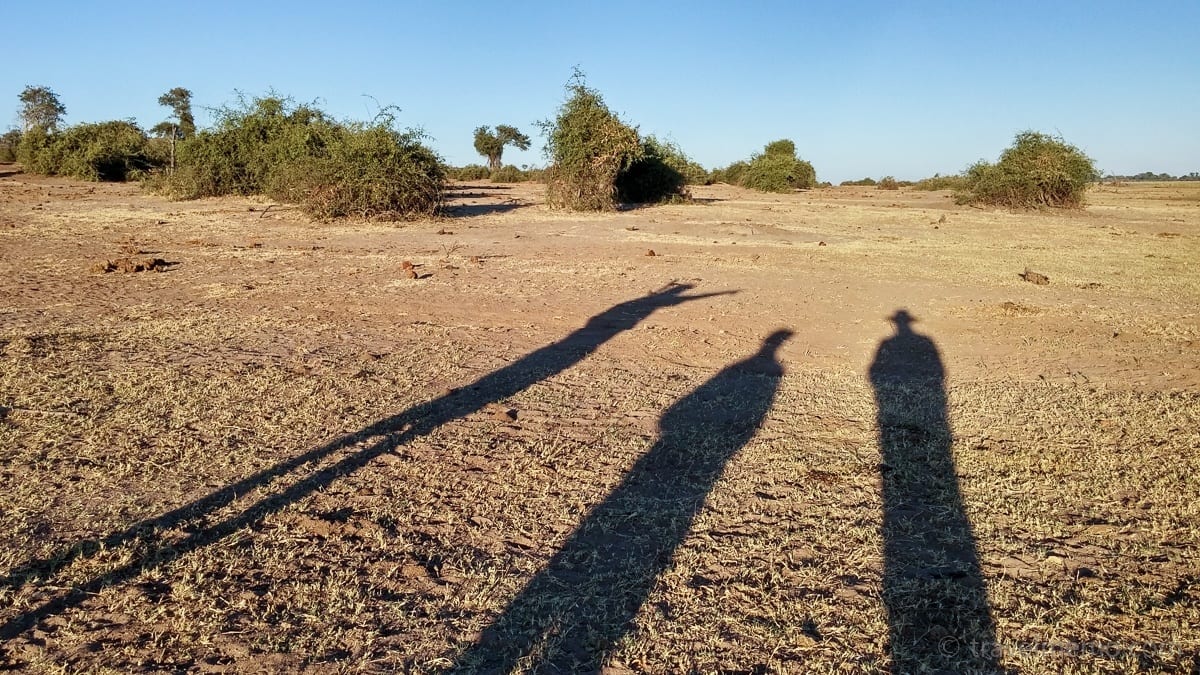During our stay at Ngoma Safari Lodge, wild dogs, jackals, and lions all showed us their fangs. And then, Peter, the lodge manager, invited us on a walking safari along the Chobe River. To be sure, with a rifle slung over his shoulder in lieu of us riding safely in a jeep… so what could possibly go wrong?

Still, we were a bit uneasy: with buffaloes, zebra, and plenty of antelopes ringing the water hole yesterday, said predators were never far away. And here we were about to do a safari on foot? …even though the staff had assured us during the previous day’s excursion into Chobe National Park (here is our review) that only in the jeep were we really safe?!
So, even with Peter telling us that (to date) nothing untoward had happened and that he was well-armed in any case, it was with some trepidation that we set out on our cross-country adventure, following in the countless, fresh(!) animal tracks.
Skirting the man-made water hole — a magnet for elephants, giraffes, and assorted other quadrupeds — we made our way down to the Chobe, a mighty tributary of the even wider Zambesi.
This morning, it was a rather quiet scene (fortunately!?). Reading the many tracks (corroborated by last evening photos), however, we saw that, besides the ever-present twitchy impalas, the elephants, zebras, giraffes, and water buffaloes, Cape hunting dogs, jackals, and other predatory fauna had also been around.
Life here happens against the imposing backdrop of the Chobe River: this being late June and the rainy season having ended, the river still ran high. The elephants happily splashed in it, hippos wallowed in its mud and the crocodiles snatched the occasional meal from it when not dozing in the sun on the river bank…
The elephant menace
Most of the pachyderms eat their fill of the lush buffalo or caracao grass growing rank everywhere: introduced by Central American missionaries for domestic use in their small ponds, the invasive weed today thrives to the point where it sometimes chokes hydro power stations and even the river itself.
The elephants and hippos couldn’t be happier of course. Indeed, given these paradisiacal conditions, their numbers have grown so large that they themselves have become the problem: Botswana alone has an elephant population of 200,000 of the animals; it could support 150,000 at most. In their present number, the herds lay waste entire forests with their destructive eating habits. It’s a piece of cake, after all, for an elephant to knock over a tree to better get at its leaves. Also, they enjoy scratching their hides on a tree trunk so much that they strip its bark, which also causes the tree to die, because with the bark go the capillary tubes that transport liquid up into the tree crown. In some places, the thick-headed beasts have created entire forests of ghost trees. It may look exotic, but this is not sustainable behavior! In fact, to protect the trunks of the last remaining baobab trees in the area from the elephants the tree trunks actually have had spiky fencing wrapped around them.
The tourists couldn’t be happier, because it’s all so picturesque! But for the local population, it’s an elephant-sized headache.
In the end, we got a lot out of our walking safari: peace and idyllic nature! And we learned quite a bit from Peter about behaviors of the animals populating Chobe National Park and how to read their signs: We were especially taken with the small beetles that dig a funnel in the sand to waylay passing ants. Any ant that tumbles into the funnel is done for: it can’t climb up its unstable surface again and is snatched by the beetle waiting in its hidey-hole
Cunning!
As our walking safari drew to its end, I asked Peter where we might spend the night in this wilderness. He came back with his mischievous advice:
Many thanks for this adventure, Peter!
Here is our review of the beautiful Ngoma Safari Lodge.